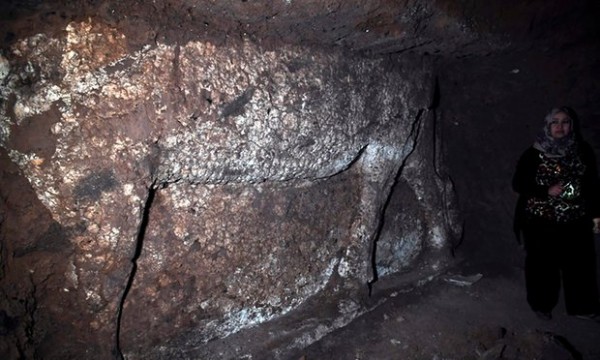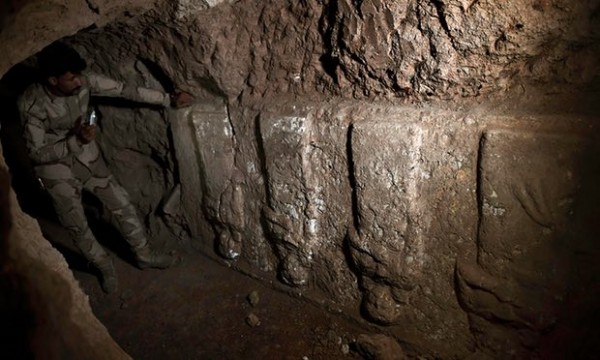
Layla Salih, head of antiquities for the province of Nineveh, of which Mosul is the capital, stands next to archeological findings. Photograph: Aris Messinis/AFP/Getty Images
ishtartv.com - theguardian.com
Maev Kennedy, Wednesday
8 March 2017
Deep
under a monument destroyed by Isis in Mosul, Iraqi archaeologists
have discovered carvings dating from almost 2,000 years earlier in a network of
escape tunnels dug by the extremists.
Archaeologists
in the west are avid for more news and better quality photographs of the carved
stone reliefs, which appear to represent priests and religious ceremonies. The
tunnels were dug under a high mound damaged in 2014 when Isis blew up a
beautiful 12th-century mosque, believed to hold the tomb of the prophet Jonah.
The
discovery of a previously unknown temple and possible palace entrance, dating
back to the Assyrian period and probably carved in the 5th or 6th century BC,
is a rare piece of good news in the context of so much deliberate destruction
and looting by Isis of pre-Islamic archaeology.
British
Museum experts in touch with their colleagues in Iraq led by Saleh Noman – who
was in the first group of Iraqi archaeologists trained in London to survey and
rescue whatever has survived – believe that the Isis tunnels ran so deep under
the centuries of mudbrick making up the ancient mound of Nabi Yunus, that they
hit a temple carved into the bedrock.
“So
far we have only seen poor quality photographs – but they are extremely
exciting,” said Sebastien Rey, lead archaeologist at the Iraq Emergency
Heritage Management Programme at the British Museum. “I met Saleh at the Unesco
conference in Paris 10 days ago, and was able to discuss it with him and look
at his photographs, and there is no doubt that they have found something of
great significance.
“The
reliefs are unique, they have features which we have not seen anywhere else –
they are not at all like the well-known Assyrian hunting and banqueting scenes
such as we have in the museum.
“We
also have reports – but as yet no photographs – that they have found two
lamassu, the famous winged bull figures, which would suggest that they may have
been flanking the entrance to a palace, with some form of temple as an annex.
“The
archaeologists are incredibly brave. They are working in extreme danger, with
the mudbrick in danger of collapse at any time. When it is safe to mount a full
rescue excavation this will be a major operation, needing a great deal of resources
which will certainly mean international support.”
Rey
is particularly excited by his colleague’s reports of inscriptions in the
stone: the Assyrian rulers, very usefully to archaeologists, were fond of
elaborate and boastful inscriptions that included their names, dates and
achievements.
It
was known that there were layers of earlier history under the Nabi Yunus
mosque, but it had never been fully excavated.
If
the tentative dating of the carvings proves correct, they date from the final
period of the once vast Assyrian empire, splintering under external attack and
internal power struggles after centuries in which it dominated Mesopotamia and
the great city of Nineveh was the largest in the world.
Magnificent
carved panels and the gigantic winged bulls, from the palaces and temples of
the emperor Sennacherib, are in museums across the world, including the British
Museum.
According
to AFP, Layla Salih, head of the antiquities service for the region, reported
that more than 100 pieces of pottery in good condition, believed looted from
the tunnels by Isis, have been recovered from a house in Mosul, and many more
portable objects are assumed to have been taken.
The
Unesco conference in Paris in February was told by the deputy Iraqi culture
minister, Qais Rashid, that in the Mosul region alone at least 66
archaeological sites had been destroyed by Isis, some of them converted into
car parks. He said that Muslim and Christian places of worship had suffered
“massive destruction”, and thousands of manuscripts had been looted.

An Iraqi troop stands next to archeological findings inside an underground tunnel in east Mosul. Photograph: Aris Messinis/AFP/Getty Images
|